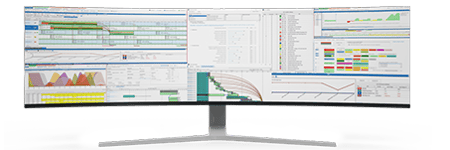The Future of Purchase Forecasting
Purchasing Managers face an increasingly complex environment in the manufacturing industry. Supply chain disruptions, fluctuating raw material costs, and evolving customer demands necessitate precise forecasting and strategic procurement. Enter purchase forecasting—a critical tool for optimizing procurement strategies and enhancing overall operational efficiency.
When integrated with advanced planning and scheduling solutions like PlanetTogether and ERP giants such as SAP, Oracle, Microsoft, Kinaxis, or Aveva, purchase forecasting can unlock significant value, helping Purchasing Managers achieve seamless operations and cost efficiencies.
This blog explores how modern tools and integrations elevate purchase forecasting, empowering packaging manufacturers to thrive in competitive markets.

The Importance of Purchase Forecasting in Packaging Manufacturing
In a packaging facility, purchase forecasting plays a pivotal role in ensuring the timely availability of raw materials such as polymers, paper, adhesives, and other essential supplies. Effective forecasting offers several benefits:
Cost Optimization: By predicting demand, manufacturers can leverage bulk purchasing discounts, mitigate price volatility, and reduce reliance on expensive last-minute purchases.
Supply Chain Stability: Forecasting ensures that critical materials are always available, minimizing production delays caused by stockouts or late supplier deliveries.
Waste Reduction: With precise forecasting, facilities can avoid over-purchasing, which helps control inventory levels and reduce material waste.
Enhanced Supplier Relationships: Accurate forecasts allow for better communication with suppliers, fostering long-term partnerships built on trust and predictability.
While these benefits are well-recognized, achieving accurate forecasts remains a challenge without the right tools and integration strategies.

Challenges in Traditional Purchase Forecasting
Despite its importance, traditional purchase forecasting often falls short due to:
Data Silos: Purchasing data is frequently isolated from production, sales, and inventory data, leading to inaccurate forecasts.
Manual Processes: Spreadsheet-based forecasting is prone to errors and lacks the scalability required for dynamic manufacturing environments.
Limited Visibility: Traditional methods often fail to capture external factors like market trends, supplier performance, and geopolitical risks.
These challenges highlight the need for advanced systems capable of integrating data and providing actionable insights.
![]()

The Role of PlanetTogether in Purchase Forecasting
Integrating advanced planning and scheduling tools like PlanetTogether with ERP systems such as SAP, Oracle, Microsoft, Kinaxis, or Aveva can revolutionize purchase forecasting. Here's how:
Unified Data Visibility
Integrated systems consolidate data from multiple sources—inventory levels, sales forecasts, production schedules, and supplier lead times—into a single platform. This eliminates data silos and ensures Purchasing Managers have a holistic view of operations.
Example: A packaging manufacturer using PlanetTogether integrated with SAP can automatically adjust purchase forecasts based on real-time production data, ensuring that procurement aligns with demand fluctuations.
Enhanced Forecast Accuracy
Machine learning algorithms within systems like Microsoft Dynamics or Kinaxis can analyze historical purchasing patterns alongside external factors (e.g., raw material price trends) to produce more accurate forecasts.
Case in Point: A Purchasing Manager can leverage PlanetTogether's analytics capabilities, integrated with Kinaxis, to simulate various scenarios and select the optimal procurement strategy.
Dynamic Adjustments
Modern integrations allow for dynamic reforecasting. For example, if a production delay occurs, the system can instantly update purchase requirements and notify suppliers of revised schedules.
Integration Impact: Combining PlanetTogether with Oracle’s supply chain modules enables real-time adjustments, ensuring procurement aligns with updated production timelines.
Supplier Collaboration
Connected platforms facilitate better supplier collaboration. Aveva, for instance, offers tools for tracking supplier performance metrics, while PlanetTogether enables visibility into how supplier delays affect production schedules.
Practical Advantage: A Purchasing Manager can use these insights to renegotiate contracts, diversify supplier bases, or request expedited shipments when necessary.

Steps to Implement Integrated Purchase Forecasting
For Purchasing Managers in packaging manufacturing facilities, implementing integrated purchase forecasting involves the following steps:
Assess Current Processes
Evaluate your existing purchase forecasting processes, identifying bottlenecks such as data silos or reliance on manual methods.
Choose the Right Systems
Select tools that align with your facility’s needs. For example:
PlanetTogether for advanced planning and scheduling.
SAP or Oracle for comprehensive ERP functionality.
Microsoft or Kinaxis for predictive analytics and supply chain optimization.
Aveva for enhanced supplier management and operational insights.
Focus on Integration
Ensure seamless integration between your planning tools and ERP systems. This can involve:
APIs that connect PlanetTogether with SAP or Oracle.
Data pipelines that link inventory and production data with purchasing systems.
Train Stakeholders
Educate your procurement team on using integrated tools effectively. Provide hands-on training to leverage advanced forecasting capabilities.
Monitor and Optimize
Continuously monitor forecasting accuracy and make iterative improvements. Use insights from integrated systems to refine supplier strategies and adjust purchasing practices.
In packaging manufacturing, purchase forecasting is no longer optional—it’s a strategic need. By integrating PlanetTogether with powerful ERP solutions like SAP, Oracle, Microsoft, Kinaxis, or Aveva, Purchasing Managers can revolutionize their procurement processes. This integration delivers unparalleled visibility, accuracy, and agility, ensuring your facility operates efficiently and cost-effectively.
Adopting these tools is not just about staying competitive; it’s about leading the way in an ever-evolving industry. Start your journey toward integrated purchase forecasting today, and position your packaging manufacturing facility for sustained success.
Are you ready to take your manufacturing operations to the next level? Contact us today to learn more about how PlanetTogether can help you achieve your goals and drive success in your industry.
Topics: PlanetTogether Software, Supplier Collaboration, Integrating PlanetTogether, Enhanced Forecast Accuracy, Dynamic Adjustments, Packaging Manufacturing, Unified Data Visibility





















LEAVE A COMMENT